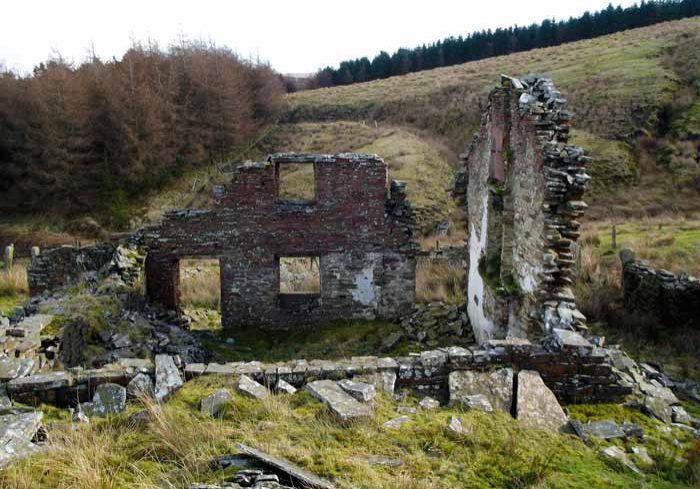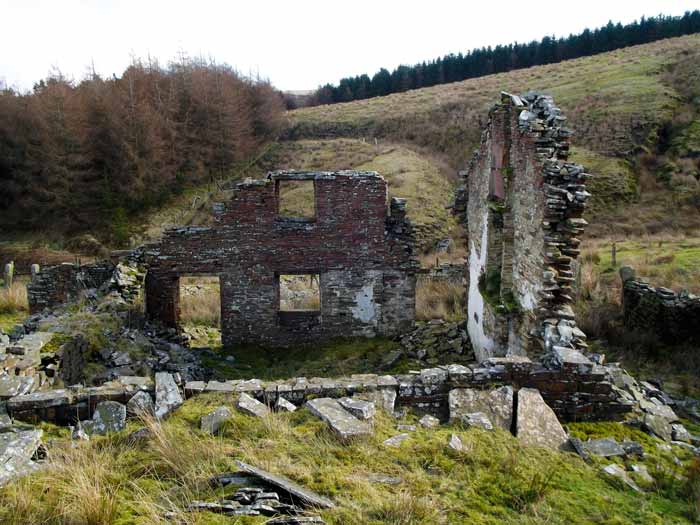
Valley of Hazels and Moonshine – Haslingden Grane
by Northern Life
by Bernard Lazenby
Ever get the urge to take off and feast your eyes on some attractive banks and braes? You do? Right then. You’ve got a couple of choices. The first is to take the high road to Fort William and the second is to head out for Little Scotland. Well all right, I agree it’s a bit confusing. But we’re not actually talking about the Scottish Highlands. It’s just the affectionate name given to what is the heart of East Lancashire. And hidden away you will find the deserted village of Haslingden Grane.
There isn’t a lot to see, but every now and again you come across clues that invite you to imagine the scene had you been walking in this area 160 years ago. Not only that, but you might also have managed to bag yourself a couple of bottles of whisky at a knock-down price!

This part of Rossendale has a great deal of natural beauty and this once vibrant little village, distinct from its larger neighbour Haslingden, has its own tale to tell. The last villager left in 1926 and now only crumbling walls and scattered stones remain of what was once a lively community – a far cry from its heyday in the 1850s.
The name grane is from the Norse and describes a small valley coming out from a longer one. Unfortunately, this cut no ice with one visitor who referred to the district as “bleak, wild and outlying”. And yes, on a grey drizzly day this may be true. But there is also a rewarding sense of timelessness and of being surrounded by what you might call an unspoilt emptiness. Certainly on the day chosen for my visit, the blue sky was peppered with large white clouds, the sun shone and there was a gentle breeze that brought the indefinable scent of spring to the nose!
Like much of England, the area was at one time heavily forested and over the years as the land was cultivated, large quantities of hazel roots have been unearthed. There are also records showing that a large part of this region was a deer park and that it comprised part of the Duchy of Lancaster.
Although I didn’t actually make the climb, on one high up stretch of moorland there are the remains of a Bronze Age stone circle. There is no other evidence from this period or indeed from the next thousand years. So it was farmers in the Middle Ages who were next to leave their mark in the form of farmsteads and other dwellings. And didn’t they give these some very strange names ? What about Mount Serat? Or Foe Edge? Then there’s Jacky Barn and Hungry Hillock. Farms that actually sound like more like a bunch of all-in wrestlers!
The local community began to increase during the early 16th century, and the people of Grane had to adapt their way of life according to the economic necessities of the times. Arable farming together with sheep rearing was their main source of income, but this had to be supplemented through various cottage industries such as spinning and weaving. There was also peat and rush cutting to give heat and light during the long winter days and nights.
Eventually, as cheaper grain from the south became available, farmers, as they do today, had to diversify. As a result, dairy-farming became more popular in order to supply the growing population. At the same time, the amount of quarrying that went on was also increased to meet the demand for paving flags in the newly built and expanding mill towns.
They do, among other things, a very tasty minted lamb barm at the Clough Head Cafe which was ample sustenance for the start of my 3.5 mile AA-recommended walk on this little journey through time.
Being a weekday, there weren’t that many folk about, but the area is obviously very popular judging by some very contented sheep who were chomping away on the coarse hillside grass. If the menu wasn’t up to much, then the al fresco dining location was superb. And if they’d only bothered to look up every now and again they’d have enjoyed gazing out onto extensive views across the shining waters of Calf Hey reservoir.
As you walk these undulating tracks, you need to look out for the odd boggy patch. But as soon as you come across your first ruined house you get a strange sensation. What confronts you is a wall still standing, with three large window spaces looking out on to a stretch of hillside topped by half a dozen wind turbines. You couldn’t see a more obvious example of the old giving way to the new. And continuing on your way, you start to think of the distances people must have travelled each day to get to and from work relying on shank’s pony come rain or shine.
Watching the late afternoon sun come sweeping across the flanks of Musbury Heights, you can appreciate the wonderful views residents would have enjoyed. Picture them sitting outside their cottages on summer evenings after a hard day on the farm or at the mill. A real Place In The Country. That said, imagine their homeward journeys in mid-winter, battling their way uphill through flurries of snow and biting winds only too glad to seek the shelter of their roaring fires and maybe a stiff whisky. Of which more later.
As the industrial revolution progressed, the arrival of mechanised spinning meant that there was much more yarn produced for weaving. Consequently, it was common for most homes in the Grane to have a loom. This in turn brought more people to the village with more houses being built and eventually, shops and a school. This growth continued until the 1840s when all cottage weaving ended and workers began commuting to nearby newly established mills. In 1863 St Stephen’s Church was built to cater for a population of around 1,500 people, although by 1926 it had been taken down and rebuilt nearer to Haslingden. Strange to think that all this prosperity would be gone within 80 years.
The slow decline in the Grane population was due partly to people moving and settling in the larger towns but also as a result of the construction of Ogden reservoir in 1912. This was the only project that directly affected local buildings and required the actual submerging of two mills and some surrounding cottages.
Two earlier reservoirs (Holden Wood and Calf Hey) had not required any land clearance. However, this time there was a fear that the close proximity of people and dwellings might cause pollution problems. Ironically, after the reservoir’s completion, the area became very popular as people adopted their previous habitat as a place of recreation. And it even had its own tea rooms!
On the subject of liquid refreshment, dotted about the countryside is evidence of rum doings. Or should that be whisky galore? Because here and there are the remains of illegal distilleries. And in some cases, individuals and families produced liquor on an industrial scale. These enterprising felons came to be known as ‘graners’ or ‘whisky spinners’ and the discovery of one of these set-ups revealed the capacity to produce enough of the stuff to fill a one hundred gallon still!
A similar vessel can be seen in an exhibition of local life at North West Water’s visitor centre along the Grane road.
When the law finally clamped down on this lucrative trade, trials took place with some heavy penalties being doled out; in one case, a fine of £200 and for the worst offenders, a prison sentence. One of the magistrates who presided over the courts was none other than Daniel Thwaite of Thwaites brewery fame.
Some interesting methods were used to transport this precious elixir around the county to hotels and pubs. These included the use of a hollow metal saddle on the back of a donkey. Another miscreant was found with whisky sloshing around in a hollow metal waistcoat. There is also a rumour that a drop of the hard stuff was regularly supplied to men working in the local quarries. You can just imagine the charge sheet: “Your honour, the defendant was found to be drunk in possession of a pick-axe!”
The final section of this interesting walk takes you through attractive woodland, past a bank of blueberry bushes (unfortunately none were available) and then alongside Calf Hey reservoir. Then, all too soon, a kissing gate brings you with a jolt onto the A6177 and the speeding traffic of the real world. But for a short time you’ve had the privilege not only of viewing some fine scenery, but also of enjoying and appreciating a small taste of a bygone age.
In recent years, The West Pennine Moors project has focused on the archaeological heritage of the area as well as creating nature trails and improving access to hitherto inaccessible areas.
There have also been attempts to lessen the impact of sheep grazing and now heather is being re-established, and who knows, one day, some long lost trees may reappear making the area look more like it once did.
In 1770 the poet Oliver Goldsmith wrote a poem which he called The Deserted Village describing the demise of a rural community which included these lines:
“Princes and Lords may flourish or may fade;
But a bold peasantry their country’s pride. When once destroyed can never be supplied”
It could serve as a fitting epitaph for the end of Haslingden Grane.





